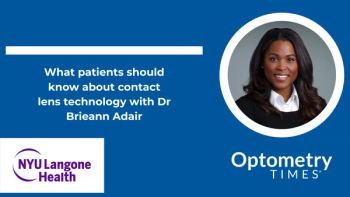
Transcript: First drug-eluting contact lens approved in Japan
Acuvue Theravision with Ketotifen from Johnson & Johnson Vision is the first entry into an anticipated category of drug-eluting contact lenses.
Gretchyn Bailey, NCLC, FAAO: Hello, I am Gretchyn Bailey with Optometry Times®. And today I am joined by Dr. Brian Pall, who is director of clinical science at Johnson & Johnson (J&J) Vision Care. We are going to talk about something new and exciting. Dr. Pall, thank you so much for joining me today.
Brian Pall, OD, MS, FAAO: Well, thank you for having me, Gretchyn.
Bailey: Recently, J&J had great news to share about receiving approval for a drug-eluting contact lens in Japan. And that is called Acuvue Theravision with Ketotifen. Did I say that correctly?
Dr. Pall: Yep, that is correct.
Bailey: Tell me a little bit about this lens. How it came about and why it is first being launched in Japan?
Dr. Pall: Well, sure. We always start with what is the unmet need, and we know in contact lens wearers that there is a significant percentage who experience ocular allergies, which leads to itchy eyes and rubbing of the eyes, which leads to a lot of frustration and reduced quality of life. So, knowing that, and knowing some of the opportunities that are there with eyedrops and potential limitations with eyedrops, the research and development team decided to look for ways that we could potentially marry a contact lens with an anti-allergy medication and get potential benefits to the contact lens wearers who are experiencing itchy eyes.
I think the second part of your question was why Japan and launchingin Japan. We know allergy sufferers are around the world and experience the same symptoms and frustrations with itchy allergy eyes during contact lens wear. So, we have committed to developing the product and then getting the regulatory approvals as we are able to. We were fortunate to have Japan become the first country to give us a regulatory approval.
Widespread approval
Bailey: So, when you say the first country, does that mean that you have other countries with irons in the fire for approval?
Dr. Pall: We are definitely committed to getting approvals in multiple countries. We are collaborating with the regulatory authorities. As you probably know, the timing and so forth for all these can be somewhat uncertain. But certainly, we are proactively trying to get approval across multiple regions.
Bailey: Do you have an estimate of a timeframe? Speaking of allergies, with a cat right there. Well played, that is Jake. So yes, he has a cameo. We commissioned him to come in and talk about allergies. Do you have a rough timeframe on where approval stands in the United States? Because that is a real area of interest for our viewers.
Dr. Pall: Certainly. So, again, the timing is uncertain right now. But, we are actively having discussions and collaborating with the FDA on making sure that we have all the right requirements met in order to get the approvals needed.
Bailey: If we switch gears for a second, and talk about the technology, because this is brand new. Tell me about how this came about and how it works. I mean, the patient can, are we putting the lens in once a day, or what's the patient going to expect? I have a whole bunch of questions. So, why don't you start talking, and I'll jump in.
Drug delivery
Dr. Pall: Sounds good. Well, listen, from a personal perspective, to be able to work on something that is the world’s first is super exciting. We talk about a lot of milestones in the contact lens industry. To be involved with the world’s first drug-eluting contact lens is something that I am extraordinarily proud of. But what is really neat is how the science works and how we are able to not only incorporate the drug but allow the drug to come out and bring benefits to the patient.
The drug, as you mentioned, is ketotifen. It is packaged and incorporated within the contact lens, which is etafilcon A material. It comes in a daily disposable modality. So, when this product—ultimately, we hope—will come to market, then patients would wake up, put the lens in their eyes, and over the course of the day the drug would elude from the lens, become absorbed by the ocular tissues, and then as they are exposed to different allergens or triggers for ocular allergies, that ketotifen, which is an antihistamine and a mast-cell stabilizer, can prevent the accumulation of inflammatory cells.
There is a triple-action mechanism that occurs with ketotifen. Ketotifen has been well established around the world for anti-allergy treatments, and it is proven to be very effective and safe. So, it is a really optimal marriage between an active ingredient and a contact lens material, which also has a long track record of safety and performance.
Matierials
Bailey: Well, let's talk about that material for a second. So, this is etafilcon Acuvuematerial, but it is now going to be used as a daily disposable. And you said that patients will wake up with the lens. So, you mean apply the lens in the morning?
Dr. Pall: Let me restate that. As a daily disposable product, the patient would wake up without a lens on, and then put the lens in in the morning. And then they would go throughout the day. At the end of the day, the lens would be removed. This is typical in a daily disposable modality, similar to 1-Day Acuvue Moist, which is also made of etafilcon A material.
Bailey: Got it. OK, so would patients be prescribed this lens in conjunction with whatever other contact lenses they would be wearing? And then the patient would decide—and especially this time of year that we are talking about, early spring—that patients would wear this lens for a couple of days, a week, a month, whatever they decide, and then return to their previous contact lenses?
Best time to start
Dr. Pall: That is an excellent question. The way that it is going to ultimately be dispensed by the eye care professional, obviously, will be very much dependent on patients themselves. We know that there are a lot of patients with seasonal allergies. So, in the spring, I am one of these who experience the itchy eyes with my non-medicated contact lenses. But there are also patients who have perennial allergies. So, indoor allergens, such as Jake and his pet dander or other sorts of dust or molds can cause perennial allergies. So, on a case-by-case basis, I think the eye care professional will likely address the individual patient’s needs and better understand what is required for treatment. Then, decide the best combination of medicated and non-medicated contact lenses, if there is a combination, with instructions of when to use.
But I would suspect that the patient would get the most benefit from getting into the contact lens prior to allergy season. You don’t want that inflammatory cascade to kick off before trying it. It would probably be more effective to start on a medicated contact lens just prior to the season and then be able to experience that comfortable contact lens wear throughout the allergy season.
Bailey: Well, I was getting a little ahead of myself asking about prescribing recommendations for a product that is not yet approved here in the United States. So, let me ask you this: What about patients who need astigmatic correction? Need a multifocal? Are we looking at line extensions for this lens?
Dr. Pall: So again, one of the areas we are committed to addressing is the needs of all the patients who could benefit from this product. Currently, the approval for Japan is on a spherical lens. But certainly, within research and development, our job is to continue to innovate as much as we can to bring this technology to as many patients as we can.
Technology
Bailey: If we go back to the technology—I know I am jumping all around here. Can you tell me a little bit about how this works? How the ketotifen is getting into the lens material? I’m assuming that it's slowly coming out on to the ocular surface. So talk a little bit about how you get the drug in there and then how the patient gets the drug on to the ocular surface.
Dr. Pall: There is an optimal marriage between the lens material and the ketotifen. It is very unique in that there is this attraction, or synergy, between the drug and the contact lens material that allows, during the manufacturing process, for the drug to be taken up by the lens. And that stays in a state of equilibrium until the lens is then removed from the package and put onto the eye.
Now, our clinical data has shown that the impact and efficacy of the medication can occur as soon as 15 minutes after the lens has been put on the eye. The duration of action is at least 12 hours. We have tested as early as 15 minutes and as long as 12 hours. The ability to get that quick onset of action and that long duration of action is through this release of the drug that happens relatively quickly and then more sustained over time.
We have presented some of this data in scientific meetings to show that there is a very consistent release over time. Several hours after the medication has been released and has been absorbed by the eye, it is able to provide a long duration of action against itchy allergy eyes.
Bailey: That is really interesting. I assume that you are looking at other medications as well for drug-eluting contact lenses for postsurgical use. I mean, there is glaucoma and there is an infinite variety of possibilities out there of how this could help patients.
Dr. Pall: Agreed. I mean, breakthrough innovation in this area, there are just so many opportunities. I mentioned that there are potential limitations with eyedrops, and so you think about the inconvenience if someone needs to dose eyedrops throughout the course of the day. The consistently reported non-compliance that patients have with eyedrops.
The other advantage to delivering medication via a contact lens, especially in a daily disposable modality is that the lens comes already in individually packaged sterile dose. Unlike a lot of other eyedrops that need to have a preservative in order to allow multiple dosing, a contact lens can already be sterile and a non-preserved product. We think that is a real advantage, especially coming back to the allergy therapeutic indication that an eye is already irritated or inflamed. Being able to treat with a non-preserved product may actually provide some benefits. From a high level, theoretical perspective, we think there is a lot of advantage to Acuvue Theravision as we treat ocular surface disease.
Bailey: Well this is all really exciting Dr. Pall. Thank you so much for taking the time to talk with me about J&J Vision's new breakthrough lens, Theravision.
Dr. Pall: Gretchyn, thank you for having me here, and I really enjoyed talking to you.
Newsletter
Want more insights like this? Subscribe to Optometry Times and get clinical pearls and practice tips delivered straight to your inbox.













































.png)


